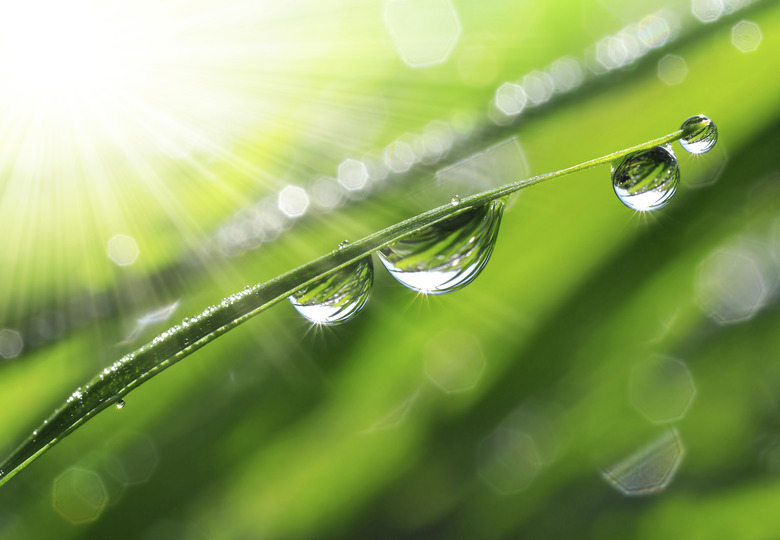How To Explain The Process Of Condensation
Big, shiny, drops of dew on a blade of grass glisten in the crisp morning air, but where did they come from? The grass is not sweating, no rain is falling, and your neighbor's lawn sprinkler isn't on. Instead, the drops appear as the result of condensation. But how to explain condensation? Some examples, along with a bit of physics can illustrate the process of condensation.
Definition of Condensation
Definition of Condensation
Condensation is a change in the state of water from a gaseous or vapor form into liquid form. It generally happens when vapor in warm air encounters a cool surface. But condensation doesn't need a solid surface to take place, as it can occur when a warm pocket of water vapor encounters cold air or other gasses.
TL;DR (Too Long; Didn't Read)
Condensation is the conversion of a gas or vapor into liquid. This process generally refers to condensation of water, but it can apply to any gas-liquid conversion.
Examples of Condensation
Examples of Condensation
Condensation occurs everyday. Some of the more common examples of condensation are:
- Morning dew: when moisture in the air condenses on surfaces and plants cooled during the night. The dew point describes the temperature air must be to condense water.
- Droplets on your can of soda: the cold surface of the can causes moisture in the warm exterior air to condense on the outside of the can. If you don't have any cans, a cold glass of water provides a cooler surface for condensed water to form.
- A foggy windshield: the air in your car contains moisture, and more is added from the breath and bodies of passengers. With enough moisture, and a cool enough windshield, the moisture condenses as droplets that fog your window.
- Foggy breath: can you see your breath? Then it's cold outside; cold enough to condense moisture into larger droplets. This is an example of condensation occurring without a surface to collect the drops.
- Clouds: the clouds in the sky are another example of condensation without a surface. The most common types of clouds form when hot air rises; it starts to cool as it rises and encounters colder temperatures. Warmer air can hold more water vapor, so as the air cools the water starts to condense to form clouds.
* Condensation Nuclei: these are specks of dirt and dust which the condensation in clouds forms on. Water has a hard time attaching to itself, so it needs another material to condense on.
- Air conditioning: uses processes of condensation and evaporation to remove heat from the air and circulate colder air inside. It uses these principles to manipulate refrigerant gasses to cool our buildings.
The Physics Behind Condensation
The Physics Behind Condensation
Like all matter, water consists of molecules. In a vapor form, the molecules are energetic, fast moving, and far apart. As the vapor encounters cooler air temperatures, the molecules become slower, less energetic and closer together. When they reach a low enough energy level, the vapor changes to liquid.
Water needs a surface or nucleation point to condense on because water molecules on their own are not large enough to stick together, so they latch on to something else.
You can do a pretty cool experiment to demonstrate the physics of condensation, with just a water balloon and some simple household items. As hot water vapor cools on the balloon, the loss of molecular energy changes the pressure, with a surprising result. The details of the experiment can be found in the Scientific American article in the references.
Evaporation and Humidity
Evaporation and Humidity
Condensation can be viewed as the opposite of evaporation; while condensation results in droplets of water forming on some surface, evaporation is a change of state where water goes from liquid water to water vapor. The relationship between the evaporation, condensation, and freezing of water molecules in the atmosphere drives the Earth's water cycle. This cycle is a continuous loop where water will change from water vapor in the gaseous state in the atmosphere to a liquid state, which can then freeze into solid ice or evaporate back into vapor. Each part of the water cycle is crucial in driving precipitation, humidity, and weather patterns on the Earth's surface. Evaporation is very helpful in many processes, especially purifying water through distillation and refrigeration.
The amount of water in the air is known as the humidity; higher humidity is a higher percentage of water in the air. Various climates have different saturation of water, resulting in different humidity levels.
Sublimation is less common to see with water because it requires a much more dramatic temperature difference. Sublimation is the process by which a solid turns straight into gas, skipping the liquid state of matter. It can be seen best with dry ice (solid CO2 gas) that turns straight into gas.
Cite This Article
MLA
Sarokin, David. "How To Explain The Process Of Condensation" sciencing.com, https://www.sciencing.com/explain-process-condensation-children-5124290/. 4 March 2023.
APA
Sarokin, David. (2023, March 4). How To Explain The Process Of Condensation. sciencing.com. Retrieved from https://www.sciencing.com/explain-process-condensation-children-5124290/
Chicago
Sarokin, David. How To Explain The Process Of Condensation last modified March 4, 2023. https://www.sciencing.com/explain-process-condensation-children-5124290/
